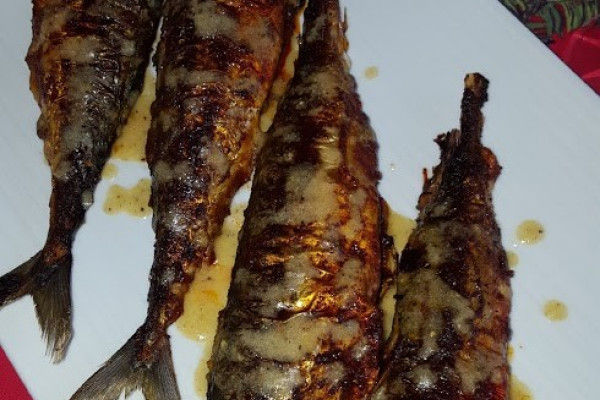
Mackerel is a tasty, local fish.
By Doreen Leggett
February is heart health month and well-known sustainable fish foodie and Chef Barton Seaver has a friend who is a doctor and dean of the Tufts School of Nutrition. He passed along three top wellness tips:
“Wear your seatbelt, don’t smoke, eat more seafood.”
Seaver repeated that advice to a virtual crowd gathered for the “Farm to Institution of New England Seafood Summit” earlier this month.
The purpose of the summit, which featured Seaver and others who preach the gospel of seafood, was to showcase the importance of institutions in supporting local seafood producers, kelp and underutilized species. The event highlighted the importance of local food initiatives, and emphasized the need for restaurants, hospitals, schools, colleges, and universities to help the region produce at least 50 percent of its food by 2060.
Seaver, a well-known author, believes that “America’s diet is killing us and it’s because of the over reliance on meat.”
He said the value of greater local seafood consumption extends beyond health, particularly for coastal communities.
“It is the opportunity for us to participate in our legacies,” he said, “our ability to stay in place and thrive.
“A fish or a water farm is us, it is what we value in our communities,” Barton told more than 200 virtual attendees.
Barton also said that when people consume local seafood, including kelp (he is a fan), they are leveling the scales of social justice, supporting values we can apply to industry.
The environmental pluses are also immense.
“Seafood has a fin up in the sustainability game,” Seaver noted.
He finds it remarkable that seafood isn’t eaten more because the country’s heritage and beginnings are so intertwined with the sea.
“The outsized importance of cod and fishermen cannot be overstated in this nation,” Seaver said. “It was one of the founding economies on which we took our first steps to economic and political freedoms.”
But, Seaver added, we turned our eyes to land and became an agrarian nation. Americans only eat 11 pounds of seafood a year (and they really should be eating 25, according to health guidelines) but what is worse is that only 10 species of fish make up 95 percent of that number.
That has to change, he said: “Diversity is in fact the foundation of sustainability.”
One of the ways to eat more fish and more variety is to start aligning our diets with the local food web, said Kate Masury of “Eating With the Ecosystem,” a non-profit emphasizing “a place-based approach to sustaining New England’s wild seafood.”
Masury said she recently went to a fish market in Maine and saw the case filled with Arctic char, Icelandic cod, Canadian halibut, but very little local fish.
Buying local helps ensure ecosystem and food system resilience, offering other benefits as well.
“If you eat (from) local waters you form a connection, you want to take care of those waters,” Masury said.
Jamey Lionette, director of the Sustainable Seafood Program at Red’s Best (an integrated seafood buying, trucking, processing, wholesaling and retailing business), had a similar message.
“Our cash crop is seafood and there is always seafood at all price points,” he said.
Lionette said his company’s emphasis is “fishermen first” so the company, which has facilities in Boston, Chatham, Martha’s Vineyard and New Bedford, tries to change the current model of demand dictating supply.
That paradigm is backwards, Lionette said, particularly when it applies to fishing, the last bastion of wild caught food.
The supply should dictate demand, he argued. Consumers should be eating what is being caught that day; one day it can be scup and the next day haddock.
“Let us pick the filet so we can pay fishermen a living wage,” he said.
Red’s also makes a point to introduce the students to fishermen. When a university gets 600 pounds of haddock they’ll also know it’s from Bob Eldredge, for example, on the fishing vessel Unicorn out of Chatham.
Tom Barton, head chef at Northeastern University and one of the panelists, said that students “want a story before anything.”
Students who enjoy hake at college begin asking for skate and monkfish, Lionette added, and when they graduate they want a variety of local fish.
Bill Blount, also a panelist, who spent close to 40 years fishing out of Nantucket before moving to New Bedford, said increasing the amount of fish sold to institutions helps fishermen stay whole. With a price floor set, fishermen make some money.
There aren’t enough chickens in New England to serve all college students, but there is certainly enough seafood, said Kevin Gibbons, head chef at UMass Dartmouth, adding they served 7,000 students a day before the pandemic.
They can experiment with different dishes, “sell the dish not the fish. We have a captive audience,” said Gibbons.
Audience members and speakers had a range of ideas on how to increase local food production and consumption.
Along with devising a way to reward fishermen and farmers for doing the right thing, lobbying government to enact legislation to offer an institutional purchase discount of 7 percent for local seafood was suggested.
People were also encouraged to support the Fishing Partnership Resiliency Fund. The Partnership is a non-profit dedicated to improving the health, safety and economic security of commercial fishermen and their families.
